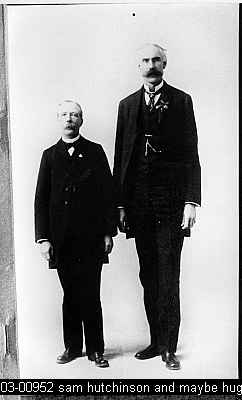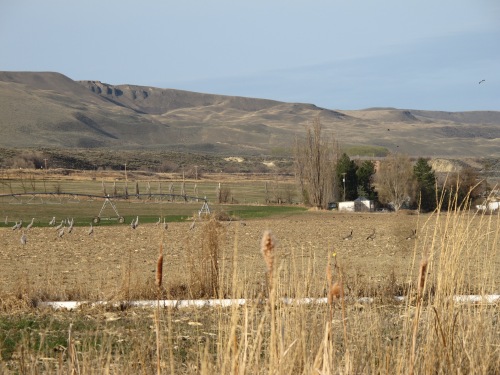
Sam Hutchinson looms over another man, possibly Hugh Dunlop in this photograph from an unidentified historical archive.
When my brothers were old enough to drive it wasn’t uncommon for several of us to pile into a car and head out into the Potholes to fish, swim or hike. We liked swimming in a certain hole in Hayes Creek. A favorite fishing spot was Hutchinson Lake, where red basalt cliffs rimmed the cool greenish waters. Even at that age, my father had told me plenty of stories about the Hutchinson brothers. My imagination placed old Sam Hutchinson on those clifftops, dressed in a black lawman’s cutaway coat and a flat-rimmed hat. Taller than seven feet, he once rode over those hills and lived in a cabin not far from where the lake is found.
Perhaps it was this image that inspired me to wander while my brother fished for those big trout that rarely got caught. I trudged out into the brush north of the lake looking for anything that might have been dropped by old Sam and he rode out one day. I found crushed and rusty tin cans, flaking apart. There were the remains of wire fencing smashed into the earth. Bits of purpled glass sparkled at me through the cheat grass. Then I found a rut. Continue reading →
Posted in Archaeology, Columbia Basin, Crab Creek, Education, Hiking, History, Native Americans, Soldiers, Trails, Transportation, Washington
Tagged Artifacts, Cariboo Trail, Central Washington, Central Washington University, Chelan, Chief Moses, Coconuts, Crab Creek, DeLorme, Desert, Eastern Washington, Education, Fishing, Fort Okanagan, Fort Vancouver, Hawaii, Hiking, History, Horses, Hudsons Bay Company, Hugh Dunlop, Hutchinson Lake, Indians, Native Americans, Nature, Potholes, Roads, Rock Creek, Sam Hutchinson, Sandwich Islands, Spokane, The Dalles, Trails, Washington, Wenatchee

Sandhill cranes frolic in the fields of the Danielson farm, with the Saddle Mountain cliffs looming over it. Photograph by Phyllis Danielson.
The communities of Oso and Darrington were devastated by the recent landslide, in which around fifty houses and more than thirty people were annihilated in the space of a couple of minutes. It will be a long time before life can return to anything like it used to be, with Darrington’s main artery to the rest of the world cut off. Now commuters from Darrington have to head north, past our Sauk River cabin, to get to their jobs, shops and supplies. It takes a lot of time and gas. My son’s scout troop raised cash and supplies that we took to Darrington last weekend, and I’ve been watching the news about the landslide daily.
Pictures of the Oso landslide reminded me very much of the landslide my family and I used to climb around on when I was a kid. One of our favorite hikes was to the cliffs at the top of Saddle Mountain, where you can climb down to a ledge where sandstone exposures have been carved by the winds and graffito-ed by generations of local visitors. Continue reading →
Posted in Cold War, Columbia Basin, Columbia River, Crab Creek, Death, Disaster, Earthquake, Education, Geology, Hanford, Hiking, History, Ice Age flood, Irrigation, Natural Disaster, Saddle Mountain, Science, Washington
Tagged Catastrophe, Central Washington, Climate, Cold War, Columbia Basin, Columbia River, Columbia River basalt, Corfu, Crab Creek, Culture, Darrington, Desert, Dr. Bruce Bjornstad, Eastern Washington, Education, Flood, Geology, Hanford Reach National Monument, Hanford Reservation, History, Ice Age, Lake Missoula, Landslide, Low Gap, Mars, NASA, Nature, Oso, Photography, Saddle Gap, Saddle Mountain, Sauk River, Senator Clarence C. Dill, Sentinel Gap, Stillaguamish River, Washington State, Wenatchee

Although Wikipedia describes this image as the steamer John Gates navigating Priest Rapids in 1884, the locality is surely not Priest Rapids, but Rock Island Rapids where the Chelan capsized on her upriver attempt and lost her rudder on her return downriver.
I’ve struggled with where to begin the story of the first steamboat Chelan. It’s a tale with roots in the larger conflicts that made the Northwest of the 1870s such a tragic and violent place. The steamboat wouldn’t even have been built if it were not for the breakout of the Nez Percés under Chief Joseph, but it wasn’t built as a direct result of that conflict. It was a response to another attempt by Native Americans to claim their natural rights and to reclaim their freedom. Even so, that was still only an indirect cause of this steamboat’s birth. It was a result of a murder by renegade Indians, angered by the deaths of their friends and family who were cut to pieces by the gatling gun mounted on a different river steamboat. Yet Chelan wasn’t built because the Perkins died. But all of these events led to the eventual arrest of Chief Moses and the removal of his followers from their land in the Columbia Basin. It was the creation of a new reservation for the Sinkiuse Indians that inspired the army to build the Chelan. The boat was needed as a ferry for crossing the Columbia River on the trail to a newly established fort that would safeguard Moses’ Indians on their new reservation.
As far as I know, no photographs of the steamboat Chelan exist. There are photographs of a later steamboat, built in 1902, which operated on the upper stretch of the Columbia until it was retired in 1910 when freight began moving by rail. The 125 foot sternwheeler was operated by the Columbia & Okanogan Steamboat Company. It was one of four retired steamboats tied to one another at a Wenatchee mooring, that burned in a spectacular fire on July 8, 1915. Continue reading →
Posted in Columbia Basin, Crab Creek, Education, History, Native Americans, Saddle Mountain, Washington
Tagged Army, Ben Hutchinson, Bridgeport, Camp Chelan, Cascade Rapids, Central Washington, Charles Maynard, Chelan, Chelan River, Chief Joseph, Chief Moses, Colonel Merriam, Columbia & Okanogan Steamboat Company, Columbia Basin, Columbia River, Crab Creek, Desert, Eastern Washington, Education, Fitzcarraldo, Fort Walla Walla, Foster Creek, Gatling Gun, History, Lake Chelan, Lt. H. B. Larson, Lt. Thomas Symons, Moses Lake, Native Americans, Nez Perces, Perkins Murder, Portage, Portland, Priest Rapids, Railroads, Rock Island Rapids, Rocky Ford, Ron Anglin, Saddle Mountain, Second Regiment of Infantry, Sinkiuse Indians, Snake River, Taunton, The Dalles, Vernita ferry, Wallula, Washington, Washington D. C., Waterville, Wenatchee, Werner Herzog, White Bluffs
 Lower Crab Creek provided water. In Eastern Washington, that was a godsend. Temperatures on the Columbia Plateau routinely soar to over 100 degrees Fahrenheit in the summertime, and rain is scarce. Cleaning irrigation ditches with a shovel west of Othello as a boy, many were the prayers I sent for even one scanty cloud to shield me from the overbearing sun.
Lower Crab Creek provided water. In Eastern Washington, that was a godsend. Temperatures on the Columbia Plateau routinely soar to over 100 degrees Fahrenheit in the summertime, and rain is scarce. Cleaning irrigation ditches with a shovel west of Othello as a boy, many were the prayers I sent for even one scanty cloud to shield me from the overbearing sun.
The Sinkiuse Indians who lived there before me probably shared my distaste for the relentless sun. But they didn’t have the benefit of a well of cold water I could retire to, an air conditioner that cooled the house when I took a break. They were stuck with the weather the way it was: hot in the summertime, cold in the winter. They took a more basic approach to living on the Columbia Plateau: they stuck close to water, or if that weren’t possible, they found the shortest route from one water hole to the next.
Over centuries of migration and travel, humans developed routes that guided them along the most direct lines of travel from one pool or stream of potable water to the next. Continue reading →
Posted in Anthropology, Archaeology, Books, Columbia Basin, Computer, Crab Creek, Family History, Hiking, History, Horses, Ice Age flood, Native Americans, Railroads, Saddle Mountain, Washington, World War II
Tagged Andrew Jackson Splawn, Anthropology, Archaeology, Astor Company, Ben Hutchinson, Beverly, Bridge, British Columbia, Bunchgrass, Burke Museum, Canada, Cariboo Trail, Celilo Falls, Central Washington, Cheat Grass, Chief Joseph, Chief Moses, Chinese, Columbia National Wildlife Refuge, Columbia Plateau, Columbia River, Colville Reservation, Corfu, Corfu Slide, Corfu Switchback, Cow Creek, Coyote Rapids, Crab Creek, Culture, Desert, Eastern Washington, Ellensburg, Environment, Family, Family History, Ferry, Frenchman Hill, Grand Coulee, Highway 26, History, Horses, Hutchinson's Hill, Ice Age, Ice Cave, Immigration, Indians, Kamiakin, Low Gap, Manashtash Ridge, Milwaukee Road, Missoula Flood, Model T, Moses Lake, Mount Adams, Nature, Nez Perce, Okanogan, Oregon, Othello, Perkins Murders, Plateau Indians, Quincy, Railroads, Ranchers, Rattlesnake Springs, Ross Cox, Rustlers, Saddle Gap, Saddle Mountain, Sagebrush, Sam Hutchinson, Seattle, Second World War, Sheriff, Similkameen, Sinkiuse, Taunton, Trails, Vantage, Wahluke, Wanapum, Warden, Washington, Washington State, Washington State Archives, Wenatchee, White Bluffs, World War II, Yakima, Yakima County, Yakima River




